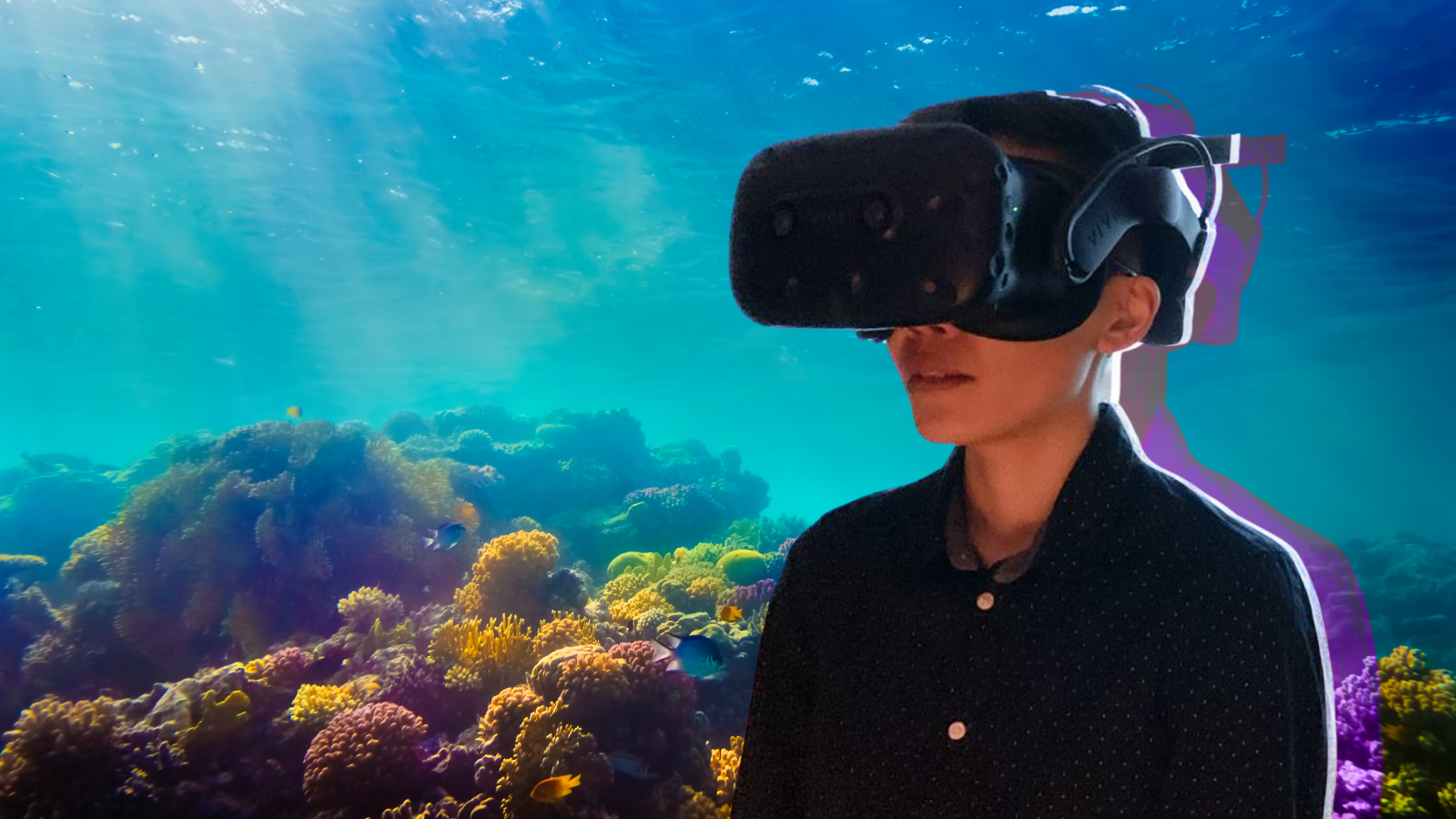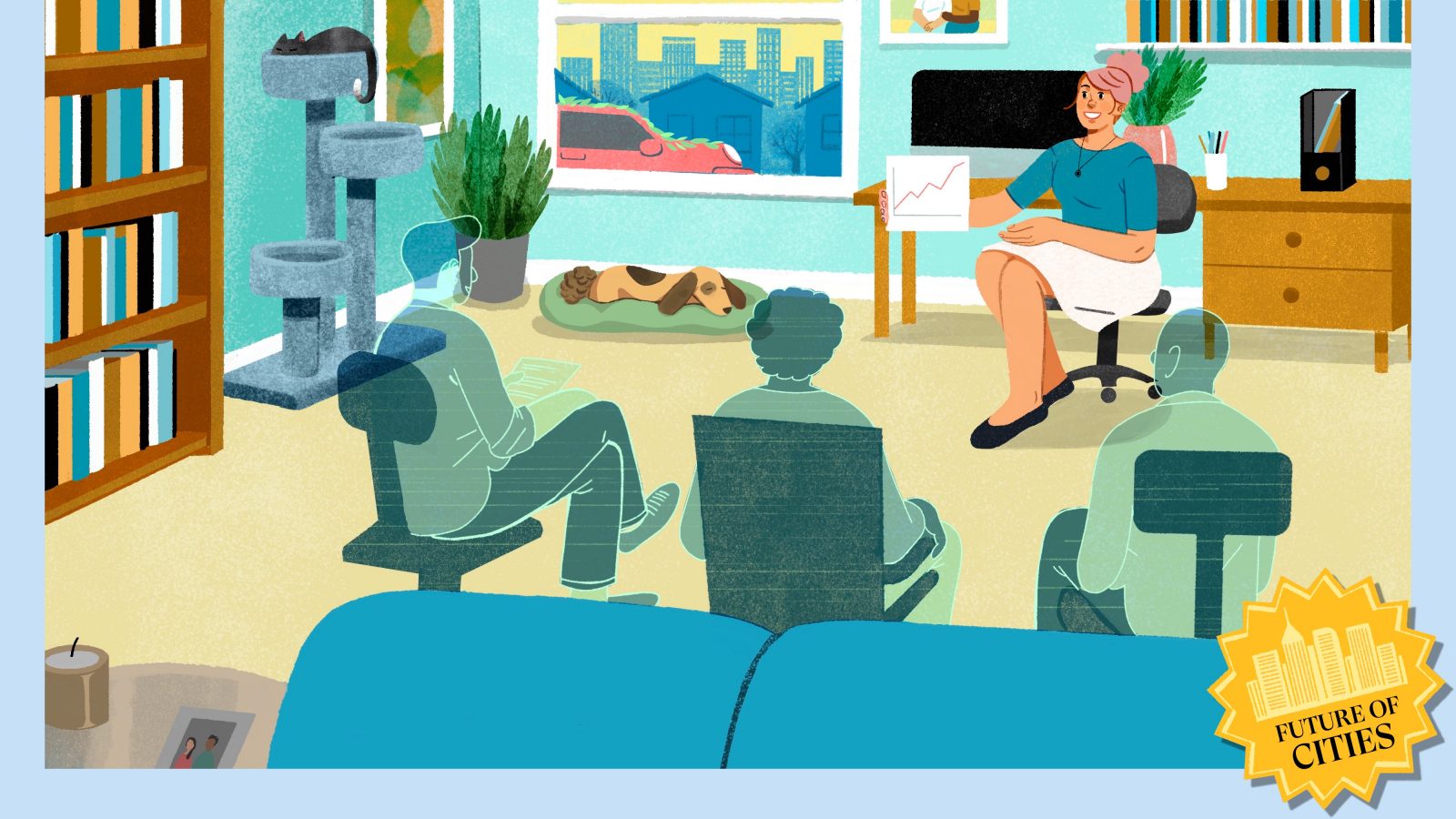You’re floating in a pale blue sky, soft white clouds swirling around you. Straight ahead, a dome suspended in the air offers a bird’s-eye view of a beach. Aquamarine water laps gently against gray stones piled beneath a metal fence, and a disembodied voice asks, “What if you had a crystal ball — and that crystal ball showed you exactly what the oceans, and the world, would look like in a future affected by climate change?”
The scene changes, dropping you onto the beach where you now gaze out at the boat-speckled sea from the island of Ischia in the Gulf of Naples. The voice continues, “What if you could go inside that crystal ball to experience it for yourself? Would you care more then?”
So begins The Crystal Reef, a 360-degree immersive experience produced by the Stanford Virtual Human Interaction Lab. As the video goes on, you follow Dr. Fio Micheli, an ocean-acidification researcher from Stanford’s Hopkins Marine Station, onto a boat and then on an underwater dive. You get to see what a healthy, vibrant coral reef looks like, then turn around to find an “ocean moonscape” stripped of life by excess carbon dioxide in the water. Toward the end of the video, Dr. Micheli tells you, “One of the most difficult parts of my research is getting people to care about ocean acidification.”
That’s exactly what the five-minute virtual reality experience intends to do.
“Getting people to care” is generally the goal of climate communication in any medium. One thing that often stands in the way of people taking climate change seriously is the notion that this crisis is far away, both in time and space. It’s a problem for future generations, or residents of another country. Another barrier is folks not seeing themselves in the climate movement — feeling that the mainstream “green” lifestyle is owned by another race, body type, or identity.
Climate stories, no matter how poignant, or personal, or well researched, may have a tough time contending with those lived experiences. But, those who study it are finding that virtual reality seems to have an advantage over other media when it comes to changing people’s perceptions — and behavior. VR not only shows you things you would never see in person (like a Mediterranean underwater landscape being devastated by ocean acidification), but, with its immersiveness and interactivity, it actually lets you do something about it.
It’s that action that you take in the virtual environment, even small things like the ability to look around at will, that researchers credit with the potential to spark behavior change. Anna Queiroz, a postdoc at Stanford’s Virtual Human Interaction Lab, ran an experiment showing The Crystal Reef and another 360-degree video to middle-school girls in Palo Alto, California. Each classroom was split into two groups — one watched the videos on computers, and the other got the fully immersive VR experience through a headset. Afterward, Queiroz quizzed the girls on how well they had learned the material, and on self-efficacy — how well they felt like they had learned the material and could be proud of what they had learned.
Both groups scored about the same in the first category. But the students that used the goggles showed significantly higher self-efficacy. They were more likely to believe that they, like Micheli, could become scientists, and could continue engaging with the topics they had learned. “The idea is that, until you actually do something, you don’t think that you can,” says Jeremy Bailenson, director of the Stanford lab. “VR gave them the active agency and the experience to help them see that they, too, could become scientists.”
Just how VR tricks your brain into making you feel like you’re doing something rather than watching something is not entirely known. Queiroz, who holds a PhD in cognitive psychology, notes that technology is evolving a lot faster than we are. The human brain isn’t accustomed to being plopped into a fully simulated environment, in which the outside world — the “real world” — vanishes. “It understands this virtual content as real,” Queiroz says. “The illusion of being in that virtual environment would trigger physiological responses that would be similar to being there in real life.”
And your actual, embodied movements let you interact with that world — instead of scrolling up, you look up, and see the sky above you. That’s part of what leads to the self-efficacy gains, according to Queiroz: When you feel that your actions create positive outcomes, even something as simple as getting a closer look at what’s being shown to you can make the material more relatable.
In the experiment with the middle-schoolers, the two versions of Crystal Reef that the students saw were fundamentally the same. The VR version didn’t include any extra steps or interactivity; the only difference was the students wearing goggles could look around instead of using a mouse to explore the world inside the video.
“We were very surprised,” Queiroz admits. Going in, she had expected to see greater differences in learning. She thought being in VR might help the students absorb the material better, but not necessarily feel a greater sense of confidence or attachment to it. But the simple fact of being immersed in the virtual environment left the girls more jazzed about what they had learned. As soon as they put the headsets on, Queiroz says, “they were just trying to see everything. They were like, ‘Oh my God, it’s so beautiful.’” The students on the computers also found the scene pretty, but didn’t show the same sense of wonder. They didn’t feel like they were there.
As with any media, there are concerns about how VR might impact people negatively — through faulty information, or potentially traumatic experiences. “You have good books and you have bad books,” Queiroz says. “The same can happen with VR, and probably will happen.” She believes it’s important for the VR community to make sure experiences are based on the most accurate scientific information available, and communicate that in a very clear, precise way. At Bailenson’s lab, the team works with experts to make sure the worlds and solutions presented in their simulations stay true to science. “We want to increase awareness and also help people to have knowledge about what can be done,” Queiroz says.
The Stanford Ocean Acidification Experience is a VR simulation similar to Crystal Reef, but instead of simply placing the viewer in the environment, it lets the user embody a scientist. In this experience, you are tasked with counting sea snails in a healthy coral reef and later, in a dead one. Before the pandemic, Queiroz and Bailenson were running a far-flung experiment with this simulation, working with around a dozen museums in places like Idaho, Oklahoma, and Texas, where Bailenson says they expected to find a great deal of variance in people’s attitudes about climate change, compared with the lab’s home base in California.
This time, the team was interested not only in how well people learned the material in VR, but also how much they trusted the information and how likely they were to care about the issues afterward.
The museum exhibits showed 16 versions of the Ocean Acidification Experience — some with a female narrator, others with a male narrator; some that explicitly mentioned “climate change,” others that did not; and some that enabled people to walk around more, versus counting snails with a pointer.
COVID interrupted their data collection and just a few hundred people had the opportunity to participate. The researchers hoped to get closer to 2,000. But Bailenson and team look forward to resuming the experiment as museums reopen, and learning more about how VR can make people care about faraway issues like ocean acidification.
“I think the greatest potential of VR is [its ability to] trigger emotions,” Queiroz says. When it comes to changing behavior, emotion is a crucial element for getting people to start and sustain any kind of shift. That’s why direct experience with climate impacts, like extreme weather events, is often credited with changing people’s minds about the climate crisis. It just isn’t personal until it’s personal. In VR, she says, “we can visualize scenarios that are difficult to visualize now — like the consequences of our actions today in 50 years, for example. And just talking about that won’t trigger emotions.”
Of course, not all VR offerings are educational, nor climate-change focused. But even ones that are neither of those things may impact how users relate to their environments. Ravi Parikh is one of thousands of gamers who are already using VR in their homes for entertainment. During the pandemic, he started playing a popular game called Half-Life: Alyx. In the first-person shooter, players navigate a dystopian landscape as the protagonist, Alyx Vance, attempting to steal a weapon belonging to enemy aliens. “I preferred to explore the world, touch objects, and soak in the VR experience,” Parikh says. The apocalypse presented in the game was brought on by alien invasion, not climate catastrophe, but Parikh, who runs a campground-booking software called RoverPass, says being immersed in the dark, dystopian landscape did change how he saw the world outside when he wasn’t playing. “Exploring a landscape of ruins and destruction was visually interesting,” he says, “but it also made me grateful to get outside in the sun and be present in the real world.”
Because VR is a new technology, it has the benefit of being closely studied. The ability of VR to boost empathy has been one hot area of research, and the findings are promising — VR participants do feel as though they have stepped not just into another person’s shoes, but into another person’s life. The possible uses of this immersive tech range from climate education to anti-bias training to high-stakes workplace drills, and beyond.
Lower-tech media like movies, podcasts, or articles are more ubiquitous, of course. Most people don’t have VR headsets. And even for those who do, or who can access them in a museum or a classroom, spending time in virtual reality can be tiring, even nauseating. That’s why Bailenson and Queiroz keep their simulations to six to 10 minutes at most. Even the researchers don’t spend more than 20 minutes at a time in VR.
Given that the tech is not yet widespread, and it’s still mega expensive for creators as well as consumers, there isn’t a ton of great VR material out there yet. “People are still trying to figure out how to make content that’s worth doing,” Bailenson says. And there are constraints that emerge when new VR experiences are released on the market — like the physical space of the people enjoying it on the other end. When Bailenson’s team dropped the Stanford Ocean Acidification Experience on the gaming platform Steam, some people complained that they couldn’t move around enough to count all the sea snails because their rooms were too small.
While it’s far from being an everyday technology for the masses, the research being done on VR today, in Bailenson’s lab and elsewhere, is giving scientists a new understanding of how to communicate in ways that not only help people care, but help them feel empowered to act. “A lot of things work really well in 2D,” Bailenson says. “I think VR is making an impact, but it’s making an impact in places where it adds immense value to be in the goggles.”
As to whether and when the technology will fully arrive, Bailenson says: “When I started doing VR in the late 1990s, there were hundreds of VR systems around the country. Going from there to a couple million active users right now, even though there’s probably 20 million headsets collecting dust — to me, that’s a big difference.”




